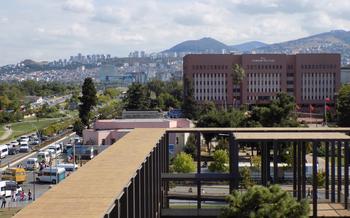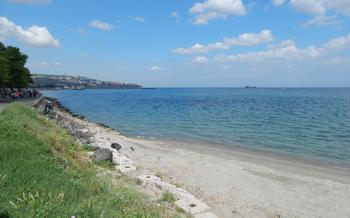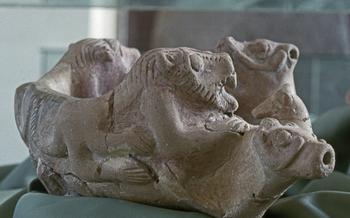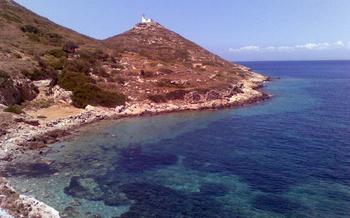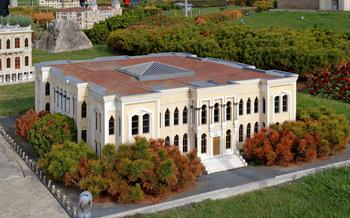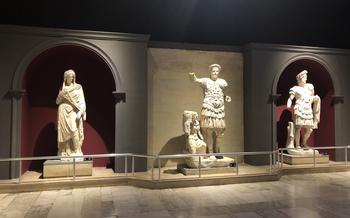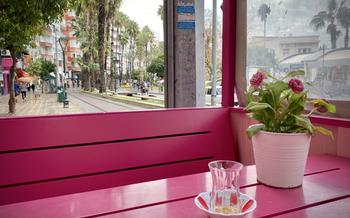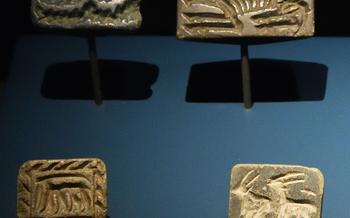
Karamustafapaşa Baths
- The Rebirth of a Historic Gem: The Karamustafapaşa Baths
- A Journey Through Time: Explore the Ancient Baths
- Unveil the Secrets of the Tepidarium
- Discover the Caldarium: A Place of Intense Heat
- The Frigidarium: A Refreshing Contrast
- Marvel at the Magnificent Mosaics
- The Latrine: A Practical Necessity
- The Water Source: A Vital Element
- The Heating System: A Masterpiece of Innovation
- The Baths Today: A Cultural Center Reborn
- Insider Tip: Experience the Baths at Night
The Rebirth of a Historic Gem: The Karamustafapaşa Baths
Deep within the heart of Kayseri, a city steeped in history and cultural heritage, lies a remarkable architectural treasure that has been meticulously restored to its former glory — the Karamustafapaşa Baths. These ancient baths, dating back to the 16th century, have undergone a meticulous restoration process, breathing new life into their majestic structures and preserving their historical significance for generations to come.
The Karamustapaşa Baths stand as a testament to the ingenuity and craftsmanship of the Ottoman Empire, showcasing exquisite architectural features that blend harmoniously with the modern world. The restoration efforts have been nothing short of extraordinary, meticulously preserving the original essence of the baths while seamlessly integrating contemporary elements to enhance the visitor experience.
The Karamustafapaşa Baths, once a thriving hub of social interaction and rejuvenation, have been reborn as a cultural center that not only celebrates the past but also embraces the present. Step into this architectural masterpiece and embark on a journey through time, where history, culture, and innovation converge in perfect harmony.
A Journey Through Time: Explore the Ancient Baths
The Karamustafapaşa Baths were meticulously designed to provide a holistic bathing experience, and each section served a specific purpose. The layout of the baths followed a logical progression, beginning with the changing rooms and gradually leading bathers through the various chambers.
The first stop on this journey was the apodyterium, where bathers undressed and left their belongings. From there, they entered the tepidarium, a warm room that served as a transition zone between the cold exterior and the intense heat of the caldarium. The tepidarium helped prepare the body for the extreme temperatures to come.
Next came the caldarium, the hottest room in the baths. Here, bathers could immerse themselves in steaming hot water or relax on heated stone benches, allowing the heat to penetrate their muscles and soothe their aches. The caldarium was also used for therapeutic purposes, as the intense heat was believed to have medicinal properties.
After experiencing the intense heat of the caldarium, bathers sought relief in the frigidarium, a cold room that provided a refreshing contrast. The frigidarium helped cool the body down and close the pores, restoring the balance lost in the caldarium.
The baths also featured a number of water channels and basins, which played a crucial role in the bathing ritual. Water was essential for cleansing, and the channels and basins allowed bathers to pour water over themselves or soak in pools of varying temperatures. The water was also used to generate steam, which filled the baths with a humid and relaxing atmosphere.
Unveil the Secrets of the Tepidarium
Deep within the heart of the Karamustapaşa Baths lies the tepidarium, a sanctuary of moderate warmth that served as a crucial transition zone between the frigidarium and the scorching caldarium. This chamber held immense significance in the bathing ritual, as it allowed bathers to gradually acclimatize their bodies to the intense heat that awaited them in the caldarium.
The tepidarium was typically located adjacent to the caldarium, allowing bathers to move seamlessly between the two spaces. Its temperature was carefully controlled, providing a gradual increase in heat that prepared the body for the extreme conditions of the caldarium. This transition was essential to prevent the shock of sudden temperature changes, which could lead to discomfort or even adverse health effects.
Architecturally, the tepidarium often featured intricate designs and embellishments. The walls were adorned with colorful frescoes, mosaics, or marble panels, creating a visually stimulating and relaxing environment. The floors were heated using the same hypocaust system that warmed the caldarium, ensuring a comfortable and consistent temperature throughout the chamber.
The tepidarium also served as a social space where bathers could mingle, converse, and enjoy each other's company. It was a place to relax, unwind, and engage in stimulating conversations while preparing for the intense heat of the caldarium. The tepidarium truly embodied the essence of the Roman bathing experience, where physical well-being and social interaction were intertwined.
Discover the Caldarium: A Place of Intense Heat
The caldarium, or hot room, was the most important part of the Roman baths. It was here that bathers experienced the intense heat that was believed to have therapeutic benefits. The caldarium was typically located at the far end of the baths, and its temperature could reach up to 50 degrees Celsius (122 degrees Fahrenheit).
The heat in the caldarium was generated by a hypocaust, a system of underground flues that carried hot air from a furnace beneath the floor. The flues also heated the walls and benches of the caldarium, creating a warm and humid environment.
The intense heat of the caldarium was believed to promote sweating, which was thought to cleanse the body and remove toxins. Bathers would often stay in the caldarium for long periods of time, sweating profusely. They would then move to the frigidarium, or cold room, to cool down. This contrast in temperature was believed to be beneficial for the circulation and overall health.
The Frigidarium: A Refreshing Contrast
In stark contrast to the intense heat of the caldarium, the frigidarium served as a place of refreshing coolness. This section of the baths was designed to provide bathers with a revitalizing contrast, helping to regulate their body temperature and invigorate their senses. The frigidarium was typically located adjacent to the caldarium, allowing bathers to easily transition between the two extremes.
The design of the frigidarium emphasized the cooling effect. The room was often smaller and less enclosed than the caldarium, with more open spaces and ventilation. Water channels and fountains were common features, providing a constant flow of fresh, cold water. The floors and walls were often made of marble or other cool materials, helping to absorb and dissipate heat.
To further enhance the cooling effect, bathers would often pour cold water over their bodies or immerse themselves in a cold plunge pool. This practice helped to constrict blood vessels, reducing the body's internal temperature and providing a refreshing contrast to the heat of the caldarium. The frigidarium also played a role in the social aspect of the baths, as bathers would often gather here to relax and socialize after their bathing ritual.
Marvel at the Magnificent Mosaics
The Karamustafapaşa Baths are adorned with exquisite mosaics that transport visitors back in time. These intricate works of art depict scenes from mythology, nature, and daily life, offering a glimpse into the culture and beliefs of the ancient world. The mosaics are not only visually stunning but also historically significant, providing valuable insights into the artistic traditions of the period.
Common themes depicted in the mosaics include scenes from Greek and Roman mythology, such as the labors of Hercules and the story of Orpheus and Eurydice. Floral motifs and geometric patterns are also prevalent, adding to the overall beauty and harmony of the designs. The mosaics in the tepidarium, in particular, are exceptionally well-preserved and feature vibrant colors that have retained their brilliance over time. These masterpieces serve as a testament to the skill and artistry of the mosaicists who created them and are a major highlight of the Karamustafapaşa Baths.
The Latrine: A Practical Necessity
A necessary component of any bathhouse, the latrine at the Karamustafapaşa Baths played a crucial role in maintaining sanitation and hygiene. Located in a secluded area of the complex, the latrine featured individual stalls designed to ensure privacy. Each stall was equipped with a stone seat and a water channel that flushed away waste.
The design of the latrine was not merely functional but also demonstrated a deep understanding of public health practices. The water channels not only facilitated the removal of waste but also helped to prevent the spread of disease. Additionally, the latrine was positioned away from the bathing areas to minimize the risk of contamination.
Beyond its practical function, the latrine also held cultural significance. In Roman and Byzantine societies, public latrines served as social gathering places, where people from all walks of life could engage in conversation and exchange news. While the latrine at the Karamustafapaşa Baths may not have been as elaborate as its Roman counterparts, it undoubtedly played a similar role in fostering social interaction among the bathers.
The Water Source: A Vital Element
A reliable water supply was crucial for the functioning of the Karamustafapaşa Baths. The water was sourced from a nearby spring, which was then channeled into the baths through an intricate system of pipes and conduits. To ensure a continuous flow of water, the system was designed with a slight gradient, allowing gravity to do most of the work.
To provide hot water for the baths, a sophisticated heating system was employed. Furnaces, fueled by wood or charcoal, were strategically positioned to heat the water in large boilers. The heated water was then distributed throughout the baths through a network of pipes, ensuring a steady supply of hot water to the various bathing areas.
The engineering behind the water system was remarkable for its time. The pipes were made of lead, which was resistant to corrosion and could withstand the high temperatures of the hot water. The system also incorporated valves and regulators to control the flow and temperature of the water, allowing the bathers to customize their bathing experience.
The Heating System: A Masterpiece of Innovation
The ancient Romans were renowned for their engineering prowess, and the Karamustafapaşa Baths are a testament to their ingenuity. The baths were heated using a sophisticated hypocaust system, a marvel of Roman engineering. This system consisted of a series of underground chambers and flues that circulated hot air throughout the building.
The hypocaust was located beneath the raised floors of the various bathing chambers. Furnaces, fueled by wood or charcoal, heated the air in these chambers. The hot air then circulated through the flues, warming the floors and walls of the baths. This system allowed for even and consistent heating throughout the building, creating a comfortable and relaxing environment for bathers.
Maintaining the right temperature was crucial for the bathing experience. The Romans achieved this by carefully controlling the amount of fuel used in the furnaces and by adjusting the dampers in the flues. This delicate balance ensured that the baths were neither too hot nor too cold, providing bathers with a truly luxurious experience.
The Baths Today: A Cultural Center Reborn
The Karamustafapaşa Baths have undergone a remarkable transformation, evolving from a historical gem to a vibrant cultural center. Today, these meticulously restored baths stand as a testament to Kayseri's rich heritage and serve as a space for various events and exhibitions. The restoration efforts have not only preserved the baths' architectural integrity but have also breathed new life into this ancient site.
The restored baths house a museum that showcases the history, architecture, and significance of the site. Visitors can explore interactive exhibits that provide insights into the bathing rituals, social customs, and cultural practices of the past. The baths also serve as a venue for temporary exhibitions that showcase contemporary art, photography, and historical artifacts.
Throughout the year, the Karamustafapaşa Baths host a variety of cultural events, including concerts, performances, lectures, and workshops. These events aim to engage the local community and visitors alike, creating a dynamic space for cultural exchange and appreciation. The baths' unique atmosphere and historical charm make it an ideal venue for these events, offering attendees a truly immersive experience.
Beyond its cultural significance, the restoration of the Karamustafapaşa Baths has had a positive impact on the surrounding area. The baths have become a focal point for tourism, attracting visitors from around the world who are eager to witness the beauty and grandeur of this ancient site. This increased foot traffic has led to the development of new businesses and services in the vicinity, contributing to the economic revitalization of the neighborhood.
The Karamustafapaşa Baths stand as a testament to the power of preservation and the importance of cultural heritage. Their transformation into a vibrant cultural center ensures that this historical site remains relevant and accessible to future generations, providing a space for education, entertainment, and cultural exchange.
Insider Tip: Experience the Baths at Night
While the Karamustafapaşa Baths are impressive during the day, they truly come alive at night. The soft glow of the lights illuminates the ancient mosaics and architectural features, creating a magical and ethereal atmosphere. Take advantage of the opportunity to explore the baths without the daytime crowds, allowing you to fully immerse yourself in their tranquility and beauty.
Capture the essence of the baths at night with your camera, experimenting with different angles and perspectives to capture the intricate details of the mosaics and the play of light and shadow. The absence of daytime distractions allows you to focus solely on the beauty of the baths, resulting in stunning and unique photographs.
As the sun sets and the city quiets down, the baths offer a serene and peaceful retreat. The gentle sound of water flowing through the channels and the soft echoes of your footsteps create a calming ambiance, inviting you to relax and unwind. Embrace the tranquility of the baths at night and let the ancient walls envelop you in their timeless embrace.
